Mexican nude. Xoloitzcuintle description of the breed, character, features of breeding and character, dog breed standard
Many people know almost nothing about the Mexican hairless dog, despite the fact that they are systematically bred in many kennels around the world. It should be noted that in most countries where the climate all year round hot you can meet such a breed of dog. They are found in Mexico, Africa, China and Peru. In our country, Mexican dogs are still considered exotic.
The most popular world favorites can be called the Mexican, Peruvian and Chinese hairless breed of dogs. These breeds have a lot in common.
Historical origin, character and description
 Xoloitzcuintli can be considered a primitive species, since breeders did not participate in the breeding of the breed.
Xoloitzcuintli can be considered a primitive species, since breeders did not participate in the breeding of the breed.
The main advantage is an amazing set of genes, good health.
It is important to consider that the Mexican hairless dog appeared about 3,000 years ago. These animals were used as ritual during the worship of the deities of the Aztecs.
At that time, ancestors were especially revered, it was believed that the deceased should be accompanied to the other world not only by relatives and people close to him during his lifetime, but also by pets.
The Aztec religion paid much more attention to the afterlife of man. Such dogs were killed with arrows, which were aimed at the throat and burned along with the owner, while it was important to wrap the neck with cotton thread.
There was a belief that the Mexican naked is the messenger of Xolotl, the afterlife deity, and will help the deceased find the gates to the other world thanks to his scent, will faithfully accompany his master further.
Hairless dogs were actively used as guards and healers.
It was believed that the dog removes the disease, but after that it must give it to the earth for some time, having been in a deep pit with silt or a puddle. In the case when the owner of such a dog was attacked by an illness that could not be cured, the animal died on its own in order to save its owner.
Xolo was also previously used as food, they were bred specifically for slaughter. For example, the Indians did this, who slaughtered these animals and cooked their protein-rich meat. It was believed that it is very tasty and tender and therefore it is mainly used for ceremonies.
Despite the fact that after the conquest of Mexico, Europeans transported many sheep and goats here, the people of this area, out of habit, did not stop eating naked dogs. Markets are a vivid example of this, where dozens of dead animals could be seen on the shelves every day.
The new owners did not properly appreciate the pets, they seemed strange to them and therefore they began to be massively exterminated and only in the most remote areas they all remained.
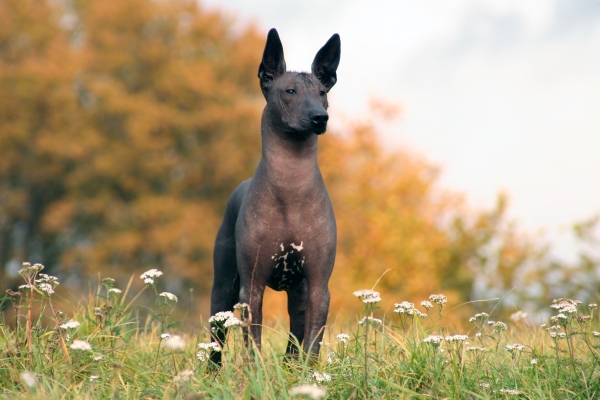
The middle of the 20th century became significant, as enthusiasts brought with them to the city from the Indian village several copies of these animals for further breeding of the breed and its detailed study. After that, Xolo became popular and recognizable all over the world.
The goal pursued was to restore the population of this breed, and as it turned out later, this was successful. Thanks to the efforts of some people and animal lovers, many thousands of these animals now live in Mexico.
For the first time, Xolo came to Russia in the 90s and at that time they were very expensive.
Now almost everyone can buy a Mexican hairless dog, as the cost has dropped significantly. Not everyone can afford them, since the animals are quite thermophilic, and in severe winter frosts it is difficult for them to survive without proper care and a warm room.
Hairless Dog Behavior and Temperament
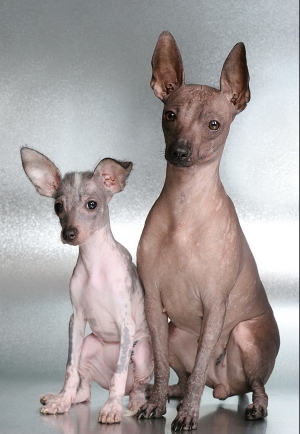 Xolo has a peculiar disposition and restrained character. Puppies are active, stocky and thick-legged, covered with numerous folds of skin, they have blunt muzzles and sharp eyes.
Xolo has a peculiar disposition and restrained character. Puppies are active, stocky and thick-legged, covered with numerous folds of skin, they have blunt muzzles and sharp eyes.
These kids do not take up energy, they eat well and as a result they soon turn into beautiful and proud dogs that attract everyone's attention.
They are cute, playful and kind, constantly in the spotlight not only because of their unusual appearance, but also because of their decency and openness in communication with both adults and children. The dog carefully observes the stranger, but after a few minutes he will still approach him in order to get to know him better and gain trust.
Unfortunately, this breed is not suitable for protecting the home, but if the owner is in danger, the Xolo will warn him about this with his bark.
An adult dog can be called sanguine, he has an excellent nervous system It is a calm and fairly intelligent animal. If he is left indoors, the furniture will remain intact, the neighbors will not suffer from the annoying howling of the pet.
During puberty, males of this breed try to dominate, but if the animal lives with a new owner for a year, it will submit and accept it as a leader. When the xolo resides in big family, then respectfully treats all members, but still pays more attention and respect to one person and follows him everywhere.
If there are other animals, then they become true friends dog. Dogs of this breed have a highly developed herd instinct, that is, all household members are a pack for him, and xolo is her leader. Going for a walk and meeting a cat or another breed of dog, he easily makes friends with them, not seeing them as enemies.
Mexican dog and animal maintenance
Features of animal feeding
The Mexican hairless dog is considered ideal in all respects. It is easy to feed it, because the animal eats everything that is offered to it, but you should not give the dog vegetables and fruits.
By nature, she is a predator and the statement that the Xolo is a vegetarian is fundamentally untrue. In their native land, they ate vegetable food at the behest of the people who fed them in order to subsequently kill them.
There should be protein in the diet of dogs, and you can give both dry food and prepared food, you should not mix all this, otherwise the animal can be poisoned, and separate food has not bothered anyone yet.
An exceptional diet for a dog can be considered beef, fresh boiled vegetables and fruits, the animal certainly will not refuse such a delicacy. Babies must be given cereals and milk, it is important not to overdo it with food and monitor the proportions of protein, as this breed can quickly gain weight, especially with reduced activity.
Xolo perfectly eat dry food of any brand, it should be noted that animals practically do not have food allergies, so when choosing a high-quality and balanced diet, you need to pay attention to the granules so that they are of medium size. This is necessary for easy swallowing because a dog may not have several teeth.
Such a deficiency is laid down at the genetic level and, most likely, is transmitted along with the complete absence of hair on the body of the animal, and interestingly, the number of teeth decreases with the growth of the animal, they simply fall out.
Housing, walk training and care
Xolo must be kept warm. It can be both an apartment and a house, because the animals will get very sick in the cold and may die. There are times when, once on the street or lost, animals find a pack of ordinary yard dogs and can live like this until severe cold weather without dying of hunger.
They are not afraid of the heat, because they were brought from the hot countries of Mexico, and there, as you know, the temperature is considerable. Xolo needs a constant and unchanging microclimate, the temperature of which should be at least 25 degrees.
If the indicator drops by five degrees, then it is recommended that the dog be dressed in overalls or a jacket, which can be purchased at specialized stores for animals, since changes in temperature can adversely affect the health of the pet and make it sick, and this is an expensive treatment, and possibly even hospital conditions and specialist supervision.
Breeders say that one should not feel sorry for dogs too much, hardening will only benefit them. According to their advice, it is necessary to let the dog outside without additional coats and overalls. At the same time, it is important to ensure that the walk is no longer than 15 minutes.
In addition, there is reliable information that with frequent use of clothing on the body of an animal, dermatitis may appear, which cause only suffering.
Training and walking naked xolo puppies
Like other representatives of the dog tribe, the Xolo simply loves walking on the street. These animals lend themselves perfectly to training, they easily learn agility or frisbee.
The child must visit daily fresh air. It is important not to overdo it and not overload it, jogging should be desirable so as not to drive the animal and reduce its activity, because fatigue can lead to many diseases.
You should not allow a puppy to play with adult dogs, since such a seemingly innocent activity can lead to serious consequences and provoke an injury or dislocation of the tendon when an adult animal accidentally presses on the xolo during a jump.
This breed of dog is not a homebody and it is difficult to keep them in one place. You should not overload the animal with many hours of work and walk with it for several hours in a row, two hours will be enough.
It is especially important to keep the ears of the animal clean. In the case when, after playing with other animals, swinging on the grass, scratches and abrasions stand out on the dog’s body, they must be treated with a special antiseptic solution. In most cases, puppies need to glue their ears so that they stand properly by the time they are one year old.
Frequent illnesses of the Mexican hairless dog
The life expectancy of a Mexican hairless dog is on average 12 to 15 years. These animals have remarkable health, and only poor-quality feeding, care and housing can contribute to the appearance of dermatitis, eczema or gastritis.
Xolo owners can be pleased that the animals do not suffer from hereditary diseases, which can significantly reduce the life of pets. If the dog is not vaccinated, then the likelihood that it will get sick is minimal, but it is still better not to take risks and protect the pet.
Chinese Corydalis dog relative of Xolo
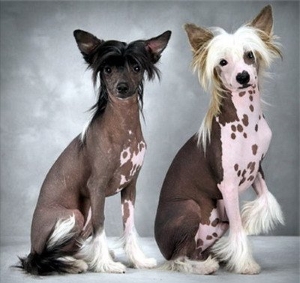 It is not known exactly which of the breeds appeared first, but one thing is clear that the Chinese Crested is a direct relative of the Xolo. These dogs came to China 2000 years ago and they were idolized and revered as a shrine.
It is not known exactly which of the breeds appeared first, but one thing is clear that the Chinese Crested is a direct relative of the Xolo. These dogs came to China 2000 years ago and they were idolized and revered as a shrine.
Great popularity for this breed came only in the 19th century of the last century. At that time, many influential personalities wanted to stand out, not an exception was W. Taunton, who bought a dog whose nickname was the Chinese Emperor and brought him to the UK.
The animal was shown at an exhibition of dogs, which was held in 1885, but, unfortunately, it did not interest dog breeders. A naked, as if shaved animal caused indignation and disgust of others who did not yet know that in the future this breed of animals would be highly valued.
In the XX century, these dogs fell in love with the Americans. Most rich people preferred to have these animals in their huge estates and estates. On the territory of the United States, many societies have been created in which lovers of this breed gather, and there is even a nomination called “The Ugliest Dog”, by the way, it is constantly received by representatives of the Xolo breed or a mixture.
In the territory Russian Federation there are a lot of these dogs and numerous representatives gather at exhibitions. There is something to love about this breed: animals are kind, affectionate and devoted to their owner. Corydalis are calm, they can not be walked for a long time and dogs perceive this perfectly, they do not annoy the owner with squeals and whining, unlike other breeds.
Temperament and behavioral factor
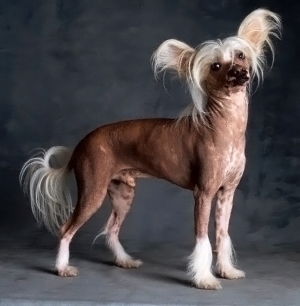 Corydalis pluses: hearing acuity, fidelity and attentiveness.
Corydalis pluses: hearing acuity, fidelity and attentiveness.
Miniature dogs with a small crest on their heads will gladly accompany the owner, no matter where he goes.
Such devotion is not intrusive, if the owner is not in the mood to play, the animal will feel it and do something else or just lie down.
Amazing sensitivity, restraint help in understanding a person. Dogs treat all family members with the same love, love children, and do not show resentment.
At the same time, the owner of the animal should not forget that the constant and tense situation, scandals, squabbles and quarrels will negatively affect the character of the pet.
The animal will become nervous and shy. If there are birds, cats or another dog in the house, the xolo will not quarrel with them or divide the territory, but rather show care, love and attention to their fellows.
Bald crested and its cons, photo
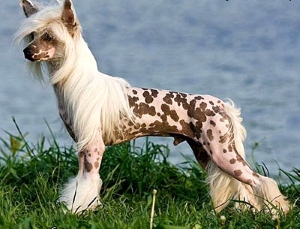 Corydalis cannot be left alone. If they are locked up, they can gnaw, tear things.
Corydalis cannot be left alone. If they are locked up, they can gnaw, tear things.
Regardless of whether a puppy or an adult dog lives in the house, they should always be under the supervision of a person and in the field of his attention. It is important not to leave the animal closed in the room where they are Appliances, if the dog gnaws through the wire, then it can be electrocuted and killed to death.
Difficulties also arise in accustoming the animal to go to the toilet in a specifically designated place, for example, on a diaper. It is necessary to walk the baby Corydalis as often as possible.
It is considered unrealistic even for adult dogs that they forget where to go to the toilet, and do it where they have to, starting from the bed and ending with household items, which, frankly, is not encouraging.
Corydalis can react aggressively to a sharp noise in the entrance and accompany it with barking. Such behavior must be corrected so as not to create additional problems, protective qualities are unusual for this breed of dog.
Little puppy should be accustomed from an early age to walks and order. It should not be allowed to go to the toilet in a tray or on a diaper, as often the animal can do this in another place, which will not please the family and puddles will begin to appear in the house more and more often.
When going for a walk, it is recommended to dress your pet in special clothes for dogs so that the Corydalis does not catch a cold. It is not necessary to consider a dog as an apartment pet and keep it near the battery in the cold, it must develop and splash out its energy, so you should walk the animal in parks, squares or places specially designated for this purpose.
Training for this breed is not required, but if the dog is a ring dog, then preparation must still be taken care of.
To this end, it is recommended to teach the dog to walk in a circle, show his teeth on demand and stand in a special stance. To do this, you can not hire a specialist, but independently study handling and train Corydalis.
It is important to do this not in the same place, but to change the environment and have people and other dogs nearby. In order for the animal to get used to the abundance of smells and noises, they try to bring them to exhibitions more often, so that in the future the animals are not afraid of such a stop.
Major diseases and how to protect your pet
- Due to the genetic predisposition, Corydalis lacks most of the teeth, which can lead to various diseases of the internal organs, in particular the stomach and intestines. Those teeth that have grown in a puppy can simply fall out with age without further restoration.
- Due to congenital dryness of the eyes, conjunctivitis and dryness can occur, which later leads to complete blindness.
- Dislocation of the pelvic bones or kneecaps requires surgery and proper care.
- Atypical dermatitis and various allergic manifestations may appear as a result of frequent wearing. The delicate skin of the dog is rubbed with coarse overalls and blouses, and eczema may appear from this.
- Acne forms on the back, which causes pain to the animal. In this regard, systematic depilation is recommended, which will help get rid of single hairs in this part of the body.
Even taking into account the presence of the above diseases, corydalis are distinguished by a long life expectancy, which averages 12 years.
How to get an animal and why you need a pedigree
Due to Chinese Corydalis it is distinguished by the presence of a large number of genetic diseases, various deviations, it is recommended to buy it exclusively in special nurseries, where a healthy population of dogs is bred and experienced veterinarians constantly monitor the animals. The puppy costs about 40,000 rubles.
It is interesting to note that, despite the fact that the Mexican and Chinese hairless dogs, although they have common roots, differ from each other in many ways, for example, in character and appearance, some are kind, the latter show aggression. Special attention attracts the health of dogs.
Xolos are hardy, strong and persistent, while Corydalis, on the contrary, are often ill and have weak immunity. But, despite this, these breeds have a lot in common and we are talking about the absence of hair and part of the teeth in animals.
The Xoloitzcuintle is an ancient dog breed that originated in Mexico. Dogs are of two types: naked and covered with hair. In our article, we will take a closer look at the Mexican hairless dog. You will learn why this breed attracts its admirers so much, and how to properly care for it.
Pronouncing the name of these dogs is not so easy, so they are briefly called "xolo" or "Mexican hairless". Previously, Xoloitzcuintle were eaten and used as sacrifices. Let's hope they don't do it now.
If you want something exotic in your home, get a hairless Xoloitzcuintle dog. This breed is considered the oldest in the world, that is, in fact, the ancestors of your pet were one of the first representatives of dog families. This is one of the reasons to be proud of your pet with an ancient history.
The Xoloitzcuintle breed is also called the Mexican hairless dog. The fact is that this breed of dog really came to us from Mexico. In their native land, the Xoloitzcuintle is a great asset and pride of their country.
Xoloitzcuintle complexions
There are 3 sets:
- Miniature dogs (weight from 2 to 7 kg, height from 25 cm to 35 cm);
- Medium dogs (weight from 7 to 14 kg, height from 36 cm to 45 cm);
- Standard dogs (weight from 11 to 18 kg, height from 46 cm to 60 cm).
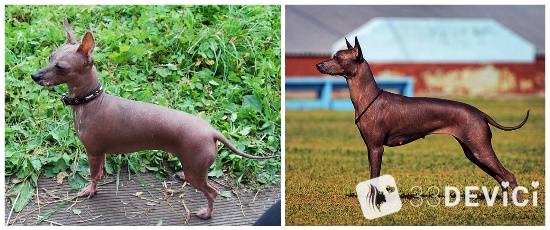
a) miniature xoloitzcuintle; b) xoloitzcuintle standard
Many people love the hairless Xoloitzcuintle dog for the warmth emanating from them. And all because most often this breed does not have a hairline. And, touching such a dog, you feel the warmth of its body and the softness of its delicate skin.
Xoloitzcuintle are also often referred to as "hugging dogs". Thanks to their warmth, no one can resist the temptation to hug such a dog. It is even said that hugging a Xoloitzcuintle can help relieve arthritis pain and lift your spirits.
Differences of the breed from other dogs
Xoloitzcuintle differ from other breeds in their specific appearance. But, despite the fact that these dogs will not be to everyone's taste because of their specific appearance, they still have a lot of features that any other breed would envy.
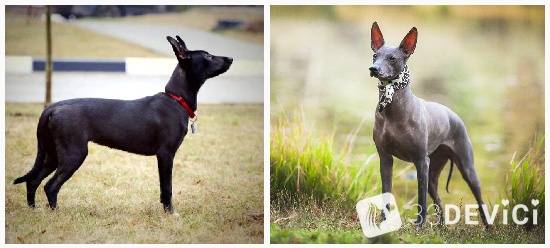
a) xoloitzcuintle with wool; b) hairless xoloitzcuintle
One of the features of this dog breed is its versatility. Representatives of Xoloitzcuintle can be not only “bald”, but in some cases also have hair. Also, dogs of this breed sometimes differ in size from each other.
Features of the Xoloitzcuintle breed
- The main feature of the Xoloitzcuintle is their appearance, most often these are completely bald dogs.
- This breed of dog is suitable for any type of home, thanks to its rich selection of sizes.
- Xoloitzcuintli will become not only a great friend to his master, but also a guard dog for the whole house.
- The absence of hair allows people to feel the inner warmth of the dog, so they constantly want to hug and stroke it. And who refuses to settle in his house "hugging dog"?
- Worldwide, there are only about 30,000 Xoloitzcuintle dogs, which is relatively small in relation to other breeds.
- The hairless Xoloitzcuintle dog is completely hypoallergenic, due to the lack of hair on it.
- The Xoloitzcuintli has an incredible hunting instinct and can easily follow other animals or game, so it makes a great hunting companion.
- Such a dog can be dressed up in beautiful outfits, because due to the lack of wool, it can be cold in autumn and winter.
- The Xoloitzcuintle breed appeared naturally, which gives it a special value.
- Since ancient times, it has been believed that Xoloitzcuintle dogs have a special healing power and can cure absolutely any disease. And even in our time, many people believe in their special power.
The Xoloitzcuintle is a dog breed with a rich history.
Xoloitzcuintle is not the only name for this dog breed. Since ancient times, they have also been called "Sholoitzcuintle". If you look at the translation from the Aztec language, then this name is deciphered as the name of the fiery God: Xolotl. The Xoloitzcuintli breed is named after him. The second part of the name is translated quite simply: dog.
How to tame a xoloitzcuintle
Xoloitzcuintli are dogs with hot Mexican blood and morals. Therefore, they have their own specific character and habits.
As a rule, Xoloitzcuintle are calm dogs themselves, but inside each of them lives a real hunter with an enviable instinct. Therefore, it will be difficult for this breed of dog to get along with other pets.
 The same applies to people: xoloitzcuintle chooses only one owner for himself, to whom he will be faithful to the last. With the rest of the family members, she will keep strictly and at a distance. But this does not mean at all that the Xoloitzcuintle will not protect them, on the contrary, this noble breed has always been famous for its fearlessness and willingness to help people. Especially representatives of the Xoloitzcuintle breed love children. It is to them that they give all their love and tenderness.
The same applies to people: xoloitzcuintle chooses only one owner for himself, to whom he will be faithful to the last. With the rest of the family members, she will keep strictly and at a distance. But this does not mean at all that the Xoloitzcuintle will not protect them, on the contrary, this noble breed has always been famous for its fearlessness and willingness to help people. Especially representatives of the Xoloitzcuintle breed love children. It is to them that they give all their love and tenderness.
Be careful when introducing your Xoloitzcuintle to strangers. In the first minutes of meeting a stranger, he will be alert and stay near you, turning on his instinct of a protector. And only after a while, the xoloitzcuintle will be able to get used to the newcomer in the house.
If you get a cat, your Xoloitzcuintle will probably chase her around the house, and even after many, many years of cohabitation, they will not make friends.
Can Xoloitzcuintle be trained?
Our answer is YES! Like any other dog, the Xoloitzcuintle is able to memorize commands and follow them. In training, it is worth using not too rough training methods. For example, if your dog is guilty, you should not raise your hand to her, just one of your stern glances will be enough, and she will understand her guilt.
The Xoloitzcuintli will do a great job of becoming a guard and protector of your home. After all, the talent of a guard dog is in their blood.
It is also worth considering the anatomical features of the dog. As a rule, all Xoloitzcuintles are athletic from birth and are very hardy. With them, it is best to choose mobile, active games so that the dog has where to spend his energy.
Taking good care of your dog
Representatives of the Xoloitzcuintle breed require special care, because their delicate skin is subject to many dangers. Since such dogs do not have hairline protection, their skin can easily burn, scratch or injure, etc.
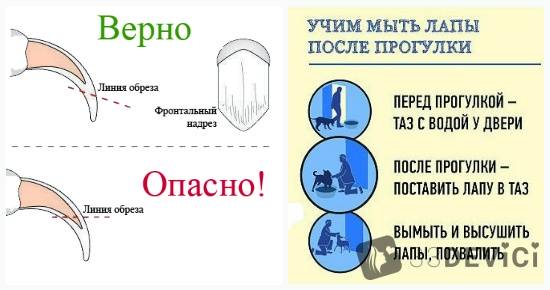
a) clipping of claws; b) washing paws
Despite the fact that Xoloitzcuintle most often lack body hair, they still need to be cleaned. It is necessary to bathe and clean the skin of your pets, especially the paws and axillary part, where the most dangerous microbes accumulate.
Xoloitzcuintle claws grow quite quickly, so it is worth trimming them in a timely manner. It's best to trim your pet's nails weekly to keep this problem from inconveniencing you.
It is also worth remembering that all dogs have very sensitive teeth. It has to do with their diet. Therefore, it is necessary to take care of your pet's teeth at least 2 or 3 times a week. Also, keep in mind that not all dogs like the process of brushing their teeth. Therefore, the sooner you begin to accustom your Xoloitzcuintle to this procedure, the faster he will get used to it and stop resisting.
There is another enemy of Xoloitzcuintle - allergies. Despite the fact that they are considered hypoallergenic dogs, they themselves often suffer from skin diseases and allergies. The most common food allergy is food.
For the Xoloitzcuintle breed, special hypoallergenic feeds are produced. But if, nevertheless, allergies could not be avoided, then you will have to fight well with the rash and sores on the skin of your pet.
There are many different creams available in pet stores to help you take care of your Xoloitzcuintle's skin. And it is they who will help your pet get rid of allergies, and simply make the skin softer and more tender.
How much does a xoloitzcuintle dog cost
The cost of one Xoloitzcuintle puppy varies from 15,000 to 30,000 rubles.
- Do not be intimidated by the specific appearance of the Xoloitzcuintle. Yes, dogs of this breed do not look quite ordinary, but it is their appearance that gives them their charm and attractiveness.
- Understand the nature of your pet. Dogs, just like us, have their own character, which sometimes needs to be learned to understand. And only by understanding it, you will be able to get along with your pet. The xoloitzcuintle has a rather complex character, because they do not let everyone in, but only a select few who they can trust. Once you enter your dog's circle of trust, you will have a true best friend.
- Take good care of your dog. Having taken the Xoloitzcuintle into your home, you must understand all the intricacies of caring for her. Pay special attention to your dog's nutrition, and don't forget to take care of his delicate skin.
- Your pet's behavior is an indicator of his upbringing. You should not blame all the problems in the behavior of your dog on its character, a lot depends on education. If no one takes care of the dog, then it will not obey anyone. We advise you not to start this business, and finally take care of the proper upbringing and training of your Xoloitzcuintle.
- Don't be afraid to take your dog to the vet from time to time. Whatever breed your dog is, it is worth showing it to a specialist at least once every six months. He will reveal the state of health of your pet, and give the necessary advice on caring for the dog.
Love your pets and show care, and they will answer you the same!
Fashionable image
The Wedding Planner
Motherhood
Design, construction, repair
Work, career, business
home economics
Psychology
Lips are one of the most attractive parts of the face, especially in women. If the skin on the lips often dries up and then cracks, you should know how to moisturize your lips at home...
Cold appetizers are a great breakfast option and a great addition to festive table. Traditional sandwiches and canapes are already fed up with many, so you should pay attention ...
Consciously or instinctively, we choose pets like ourselves. Therefore, if you know what kind of animal lives in the house of a particular person, you can almost accurately determine its character and habits ...
A special, unique, pleasant smell gives a woman a great mood and self-confidence. It turns out that based on various essential oils you can make your own perfume...
The smell of a room is the first impression that our senses receive when we cross the threshold of a house. Therefore, it must be pleasant. We will tell you how to make an air freshener at home from simple and affordable components...
mexican hairless dog
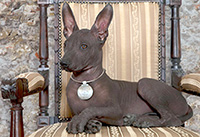 Per thousand years of history coexistence of a dog and a man, selection, as a science, gave the world a great variety of breeds of these beautiful noble animals. Today we will talk about the Xoloitzcuintle - one of the most ancient and most mysterious breeds. It is better known to us as the “Mexican Hairless Dog”, “Mexican Hairless Dog”, “Xolo” or “Sholo” (named after the deity Xolotl, which these animals symbolized).
Per thousand years of history coexistence of a dog and a man, selection, as a science, gave the world a great variety of breeds of these beautiful noble animals. Today we will talk about the Xoloitzcuintle - one of the most ancient and most mysterious breeds. It is better known to us as the “Mexican Hairless Dog”, “Mexican Hairless Dog”, “Xolo” or “Sholo” (named after the deity Xolotl, which these animals symbolized).
Story
It is believed that the dog came to Mexico along with the colonizers of this rocky area - the northeastern nomadic tribes, the ancestors of the Aztecs. Tailed representatives of this breed were considered guides to the world of the dead and were often used in various rituals. The indigenous people used dog meat for food, believing that this delicacy has magical properties: the god Xolotl himself sends grace through the flesh of animals. Often, the unfortunate sholo were sacrificed to pagan deities and interred with the next deceased member of the tribe.
Not a single cult rite could do without the participation of Xoloitzcuintle, which later played a cruel joke with them: dogs, like the pagan past of local tribes, began to be massively exterminated by the Spaniards, who came to conquer Mexican lands, and at the same time destroy the entire cultural space of the Mexican peoples.
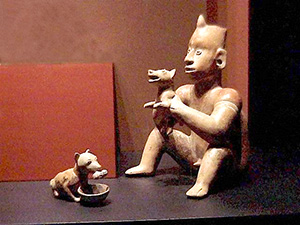
Fortunately for the Mexican hairless dog, the brutal repression of the religious past of the indigenous population soon faded away, and the Xoloitzcuintle population increased dramatically. Now sholo can be found almost anywhere in the world, including Russia. By the way, the breed was brought to Russia about 40 years ago and quickly took root in the vastness of our country.
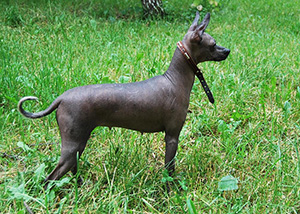
Character
Xolo dogs are distinguished by unprecedented sociability and good disposition. Sholo will be glad to any guest who comes to the house, he will perfectly find mutual language with adults and children, gets along well with other pets.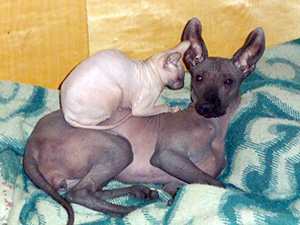
However, besides this, the Xoloitzcuintle is a loyal and courageous defender. Despite their small stature and rather fragile build, representatives of this breed will rush to the offender of the owner without hesitation, becoming the protection of his safety.
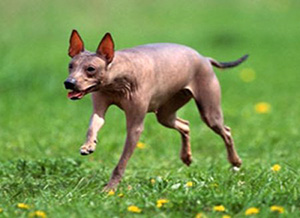
Sholo is different enough high level intelligence and unparalleled cunning. At the same time, she is quite obedient and easily trained to commands.
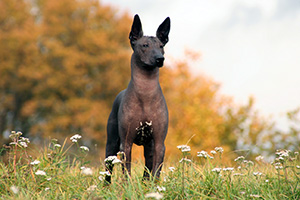
Peculiarities
The bare skin of the dog makes it an indispensable pet for those who are allergic to animal hair. It is worth noting that this is the special uniqueness of the Sholo - the breed is listed in the Guinness Book of Records as an animal with the highest body temperature (in addition, the Mexican bald dog is noted in the aforementioned book as the oldest dog breed).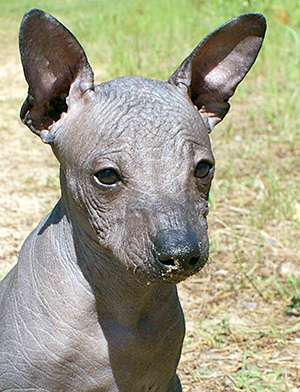
The skin of these pets is an excellent conductor of heat, since wool, due to its absence, does not filter the amount of heat generated. This makes the surface of the dog's body very warm, soft and tender. From this, the skin of the animal is especially susceptible to the negative effects of ultraviolet rays, but these dogs tolerate frosts perfectly. You should not, of course, allow the body to freeze, but it is also not necessary to protect the dog from winter walks - these measures are completely unjustified. In the absence of hairiness on the body of the Mexican dog lies another plus of this breed - fleas cannot start on the body of the Xolo and thereby cause inconvenience to the owners with whom the dog is in constant contact.
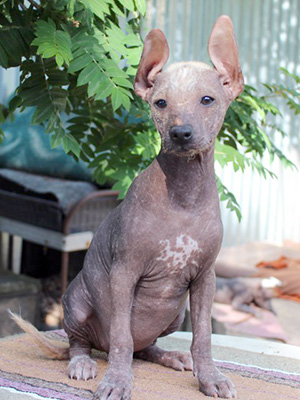
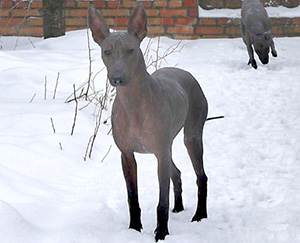
Body type
The physique of the Mexican hairless dog is quite strong - dry bones, strong chest, powerful paws and wide forehead bones. Despite its small stature and thinness, Xolo is hardy and it is simply impossible to tire her with long walks. Such a dog does not suffer from shortness of breath or from fatigue.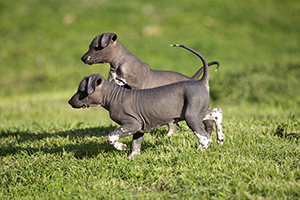
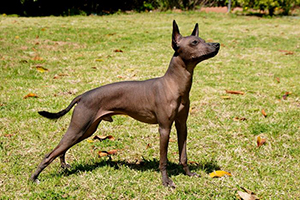
healer
Sholo has long played the role of a heating pad for their owners, which is popularized in the circles of lovers of this unique breed of dogs to this day. The high body temperature of the animal makes it indispensable assistant with rheumatism and diseases of the joints of various kinds. In addition, the warmth emanating from the dog has a positive effect on the pressure of a person, so allowing Sholo to take a nap in your arms, you have a positive effect not only on your mental health, but also on your physical health.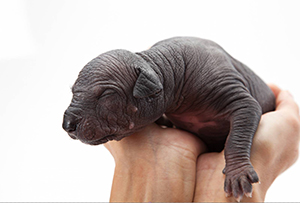
Kinds
There are 3 types of Mexican hairless dog: miniature, medium and standard, which makes representatives of this breed universal pets suitable for any rhythm of life of its owner and any square meters on which the dog will "drive". In addition, xolos are divided into 2 more types - naked and downy, so sholo is a unique breed that amazes with a range of appearance features.
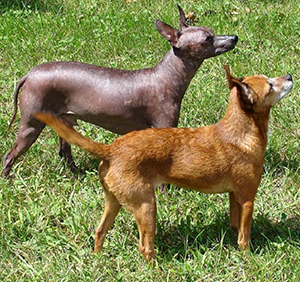
Having once settled this naked little creature in your house, you will fall in love with his hot nose and never again want to change your choice and get a representative of another breed. Xoloitzcuintli fall in love with themselves at first sight, which you will only be happy about.
Xoloitzcuintle dog breed mexican hairless dog, possibly descends from the first dogs that set foot on the American continent. In their native Mexico, and throughout Central America, they believe that the warmth emanating from them cures arthritis, asthma, rheumatism and insomnia. People still love to cuddle with a healer dog.
Xoloitzcuintli photo
Characteristics:
- Adaptation level (3/5):
- adaptability to life in an apartment (5/5)
- suitable for novice owner (1/5)
- sensitivity level (5/5)
- tolerance for loneliness (1/5)
- cold tolerance (3/5)
- heat tolerance (3/5)
- Friendliness (3/5):
- attachment to family (5/5)
- love for children (3/5)
- friendliness to other dogs (2/5)
- attitude towards strangers (1/5)
- Health and care (4/5):
- degree of shedding (5/5)
- salivation (1/5)
- ease of care (5/5)
- general health (5/5)
- tendency to be overweight (3/5)
- size (3/5)
- Learnability (4/5):
- ease of training (3/5)
- intelligence (5/5)
- tendency to use teeth (3/5)
- hunting instinct (5/5)
- tendency to howl and bark (5/5)
- traveler potential(5/5)
- Training Needs (3/5):
- energy (3/5)
- intensity (3/5)
- need for motor activity (3/5)
- playfulness (3/5)
Main parameters:
- Group: Companion dogs.
- Height at the withers: standard 35-60 cm, miniature up to 35 cm.
- Weight: 4-20 kg.
- Life span: 14-20 years.
Description
At first glance, and sometimes from the second and third, the Xoloitzcuintle is not very attractive. A wrinkled forehead, slanted eyes, huge ears, a "mohawk" of coarse wool along the skull, a rat tail and an almost naked body make the Xolo a dog that only a mother will love. Well, except for people who appreciate the very differences that make her stand out from other breeds.
However, looking closer, you will see a harmoniously built, strong, thin dog with well-developed muscles. The wedge-shaped head gradually tapers towards the nose. Lively and intelligent almond-shaped eyes in different individuals change color from yellow to black. Thin translucent ears have a delicate texture. Sometimes puppies are covered with wrinkles, but with age, the wrinkles disappear.
Xolo has virtues that are invisible to the eye. He has a calm nature and moderate needs for exercise. Experts attribute the Mexican bald to the primitive breeds. This means that they are stubborn and prone to the manifestation of predatory instincts. Neighbor cats and other pets will not feel safe.
The absence of wool does not mean that you are not in danger of allergies. Her skin still peels off, and the body secretes saliva and urine. Before you spend a lot of money on a purebred puppy, hang out with a few adult Xolos for a while and make sure they don't make you runny or sneeze.
Think carefully before you get yourself a pet with such an unusual character. But if you really wanted to always have a source of living healing heat nearby, protecting you from diseases and evil spirits, then the Xoloitzcuintle is your dog.
Peculiarities
- Three growth varieties of xolo are known - small (up to 35 cm at the withers), medium (up to 45 cm) and large (up to 60 cm).
- Another name for the breed is the Mexican hairless dog.
- Despite this, there are also individuals covered with wool.
- The breed has been known since the pre-Columbian era.
- The Xolo's body is slightly longer than her height.
- This is not only a companion, but also an excellent watchdog.
- Her body temperature is no greater than that of other dogs, but due to the lack of hair, she seems warmer than them.
- In 2011, the American Kennel Club listed the Xoloitzcuintle as a non-sporting breed group.
- Their number in the United States is less than 1,000 individuals, in the world - approximately 30,000.
- Xolo is considered hypoallergenic, although sensitive people can respond to it.
Story
The breed has been formed for centuries not by crossing, but by natural selection. Apparently, some spontaneous genetic mutation served as the impetus for its appearance. Archeology confirms that the distant ancestors of these dogs accompanied the first migrants who entered the American continent through the isthmus in the Bering Strait.
The name of the breed is translated from the Aztec language as "the dog of the god Xolotl", who was considered the lord of life and death. According to legend, God sent his dogs to earth to protect people from troubles and diseases, and then escorted them to afterworld. Xoloitzcuintli were bred at temples, killed as a funeral sacrifice, and the meat was eaten. Today, of course, no one would do anything like that.
The eradication of paganism did not lead to the disappearance of the breed. On the contrary, it flourished and even became fashionable. In 1887, she was first officially recognized by the American Kennel Club. Xolo is present in the paintings of Mexican artists Frida Kahlo and Diego Rivera. But then came a decline in popularity, and the breed almost disappeared. Only the efforts of enthusiasts saved her. Now the Xoloitzcuintli is considered a national treasure of Mexico.
Character
An adult dog of this breed is calm, but wary of strangers. She is attentive and affectionate to all family members, but she shows special affection to one of them. Always strives for close contact, warming a person with its warmth. Long walks in nature are not necessary for her, a daily workout in the yard is quite enough. The rest of the time, the Xoloitzcuintle happily basks in the sun or naps, cuddling up to the owner.
Xolos are excellent watchdogs and great owners. Silent in a calm environment, they instantly and violently react with loud barking to any attempts to violate the boundaries of the controlled space. A house or a personal plot is perceived by them as a personal property, where strangers are not allowed. Xoloitzcuintli requires mandatory socialization and training. Otherwise, uncontrolled aggressiveness towards strangers and animals is possible. But the rest of the pets are completely safe.
A smart and sensitive dog easily learns the wishes of his owner and quickly finds an approach to him. He does not even need to be punished - a stern look is enough to bring him to obedience. But the Mexican Xoloitzcuintle learns to manipulate the owners very quickly. Inexperienced owners need to remember this and combine manifestations of love with reasonable severity.
Harmonious build and strong muscles make Xolos excellent athletes. The owner will have to worry about a reliable fence personal plot, because adults can easily overcome a two-meter fence. And the puppies will not be stopped even by a meter obstacle. They are active, constantly playing and, left unattended, can cause considerable damage to green spaces, furniture and shoes.
Puppies have different temperaments. In the litter there are always modest people huddled in the corners and evil fighters. It is better to choose someone who is kept in the center, cheerful and friendly. The sooner a Xoloitzcuintle puppy is socialized and trained, the better. Walk with him more often in busy places, invite guests, accustom him to other pets. Having matured, he will not be a coward or, conversely, show aggressiveness and disobedience. The owner will become an indisputable authority for the Xolo.
Health
The breed is considered healthy and strong, therefore buying a puppy from a responsible breeder with an excellent reputation guarantees the absence of serious diseases and genetic disorders. It is recommended to get offspring from dogs at least 2 years old. This guarantees a healthy heredity. Puppies must be vaccinated and treated for worms.
Xolos were formed in a tropical climate, so they are not afraid of heat and bright sun. However, individuals with light or spotted coats need occasional sunscreen treatment. There must be a shady place in the yard where she can take a nap in the chill. In winter, in the cold, they should be taken out for a walk in insulated overalls. Rigid skin is very durable and heals quickly with cuts and abrasions.
Completely hairless Mexican dogs lack premolars between canines and molars. This is not a disadvantage and does not affect the evaluation of the show judges. Interestingly, this trait is closely related to the presence of wool. The variety covered with it has a complete set of teeth.
Care
The hairless Mexican dog has a smooth but tough skin that fits tightly on the body. Wrinkles are only on the muzzle. Sometimes there is hair along the skull between the ears, on the legs and the last third of the tail. The woolly Xolo is completely covered with short and smooth hair. Colors range from various shades of black to copper red and bronze. Light and completely white spots are not uncommon.
Do not think that a hairless dog does not need care. It is unlikely that she will get fleas, but regular bathing every two weeks is essential. Use special mild shampoos. Wash her paws after every walk. If you applied sunscreen before the walk, be sure to wipe it off.
Trim your nails regularly. Xolo do not like this operation, so teach your puppy to it from the first days living together. The same applies to brushing your teeth. It is carried out 2-3 times a week to prevent the formation of tartar.
Examine your dog regularly, check for inflammation, rashes, any signs of infection. Pay special attention to the search for sucked ticks. Xolo ears should not have bad smell and be filled with sulphur. Eyes always remain clear and alive.
Often puppies get offended when they are brushed, pawed, mouth and ears examined, so try to make this process more enjoyable with praise in the form of treats. In the future, the pet will even become more obedient thanks to such procedures.
In addition to all this, you should periodically check the entire body of the dog for various wounds, infections and inflammations. Carefully inspect the mouth, eyes, ears, nose and paws. This will help to immediately identify potential health problems and prevent them, avoiding serious consequences. The pet's ears should not smell like wax or manure, and the eyes should not be red and tired. If any symptoms are found, a veterinarian should be consulted immediately, otherwise serious complications may occur.
Feeding
Recommended daily rate Xolo food ranges from 0.6 to 1.75 cups of high quality dog food. They should be divided into two servings - morning and evening. Don't overfeed your dog, but don't leave him hungry either. The amount of food depends on many factors - physical activity, individual features body and the need for diet.
Try to prevent excess weight gain by controlling the quantity and nutritional value of the feed. But again, you can’t leave the dog hungry either. Looking at the pet from top to bottom, the waist should be clearly visible. Running your hands along the sides, it’s good if the ribs are felt a little and they are not visible at the same time. If your dog is overweight, increase the amount of exercise and reduce the portion size.
It is important to understand what largely determines the quality and duration of her life. Recommendations and comments of dog breeders on specialized sites and forums make you seriously think about the issue of feeding your pet. Choosing good food and following certain rules will allow your dog to live happily ever after!
Communication with children and other animals
Mexican hairless dogs are good with children, especially if they grow up with them. But do not forget that this is not a good-natured retriever. Never leave them alone with small children, who may tug on their tail or ears. Xolo bites first, then thinks. Teach your child to be careful with it, do not let him approach the bowl while feeding the dog.
The same applies to pets. Xoloitzcuintli perfectly distinguishes "their" cats, guinea pigs and other animals from strangers. The attitude towards the former is loyal, but strangers are ruthlessly pursued until they leave the protected area.
nurseries
With the help of a list of breed organizations, buying puppies will become much easier. Also in kennel clubs you can get additional information about this breed and learn about the characteristics of the dog from the owners themselves.
Dogs of the breed with the hard-to-pronounce name Xoloitzcuintle, which are also known as the Mexican Hairless, Xolo, Xolo and Xoloitzcuintle, not only have a very original appearance, but also belong to the oldest canine representatives on our planet. Their history spans several millennia.
History of the breed
This breed has two varieties: hairless and woolly. Xoloitzcuintle, covered with wool, were known as early as 7-8 millennia ago. In the course of evolution, an inexplicable mutation occurred, as a result of which some puppies began to be born without hair. This mutation turned out to be favorable and stably fixed. The history of the naked variety of Xolo has about 2-3 millennia.A confirmed fact is that the Indians ate the meat of these animals for food, since before the Europeans arrived in Mexico, they did not have any other large animals at their disposal. Mexican hairless dog treats were commonly served during celebrations and sacrifices.
Today, collectors all over the world are willing to pay crazy amounts of money to add at least one of these relics to their collection. And some dream of having such a sacred dog in their home.
Appearance
Xoloitzcuintle are harmoniously built dogs with a proportional, strong and slightly stretched physique with pronounced musculature and a strong back.Three types of breed are distinguished by size: miniature (height at the withers from 25 to 35 centimeters and weight 3-6 kilograms), medium (height 36-45 centimeters, weight 7-14 kilograms) and standard (height 46-60 centimeters, weight 15 -30 kilograms). As already mentioned, two varieties of the breed are also distinguished by the type of wool: naked and covered with wool.
For the naked variety, one of the most important characteristics is the skin, which is elastic and smooth, and warm and pleasant to the touch. The skin of the Coloitzcuintle is very strong and thick, it is resistant to the bites of various insects, sunburn and other damage.
In hairless dogs, a dark solid color is preferred. Allowed presence white spot on the abdomen, chest or legs. Completely white is a disqualification fault. For the coated Xolo variety, any color variant is allowed. However, brindle and marble colors are considered undesirable.
The nature and characteristics of the breed
Xoloitzcuintle are not only the owners of a bright aristocratic appearance, but also have a magnificent character, harmoniously combined with a high level of intelligence, quick wit and feeling dignity. In addition, they are very sensitive creatures, desperate for both emotional and physical intimacy with their beloved master. Representatives of the breed constantly require communication, caresses and tactile contact from their owners. Therefore, if you do not have enough time that you could devote to your dog, then it is better to opt for another breed.Xolos are great friends and companions for all family members. Also, despite their graceful and sophisticated appearance, they are very bold and brave creatures, which allows them to become reliable guards.
It is believed that Xoloitzcuintle are able to cure numerous diseases, such as toothache or asthma. The heat from the pet's body helps to quickly relieve pain from rheumatism or bone inflammation. As you know, ordinary dogs do not lie down on a sore spot of a person, but this does not apply to Xolo. Also, these animals are considered the protectors of the house from evil spirits. Owners often comment on the Xoloitzcuintle's special way of looking at the world. Sometimes, dog breeders say, they look into the distance so intently, as if they see something that we cannot see. People believe in such magical abilities also because Xolo lack certain teeth, namely premolars. In addition, these dogs are very loyal and attached to their place of residence.
Xolo is an ideal dog to keep at home. The hairless variety of the breed almost never causes allergies and does not have a specific dog smell. The skin of the naked variety does not require special care. When bathing such animals, it is advisable to use baby shampoo or shower gel. A hairy Xolo can be bathed using special shampoos for short-haired dog breeds.
Representatives of the breed have a unique ability to adapt to different conditions residence. V winter time with them you can even go for short walks without clothes. However, for a long stay in the cold, a naked Mexican dog should be dressed in a warm jumpsuit. In addition, Xoloitzcuintle have good health and almost never get sick.
True, these dogs really do not like the cold, so at night, as well as in the cold season, they need to be covered with a warm blanket. Also, their skin is advised to wipe with oil or lubricate with baby lotion. By the way, it is recommended to bathe xolo every week with a mild shampoo without dyes and chemical additives. As for feeding Xolo, they are not picky at all. They can eat both protein and plant foods, love fruits and vegetables. Xoloitzcuintle are very calm and balanced dogs, they have a restrained and meek character, therefore they get along well in families with children and other animals.
Detailed description of the breed
- Height at withers, weight. Miniature (height at the withers from 25 to 35 centimeters and weight 3-6 kilograms), medium (height 36-45 centimeters, weight 7-14 kilograms) and standard (height 46-60 centimeters, weight 15-30 kilograms)
- Body type. Strong physique.
- Head. In keeping with her "wolf" type, her skull is broad, strong, yet very elegant. Gradually tapers towards the muzzle. The occiput is barely pronounced.
- Eyes. Medium size, almond shaped.
- Ears. Long, large and expressive. They look like bat ears
- Neck. Highly carrying, upper line slightly curved.

